We’ve arrived at eclipse day, so now the big question is, will it be clear? My favorite forecast for major astronomical events reads something like this: Fair skies tonight with light winds and lows in the middle 50s.While I hope that’s exactly what’s predicted for your town, in my corner of the world we’re expecting “increasing clouds with a chance for thunderstorms”.
That’s just not nice. Same by you? Here’s how to find that clear spot if you’re facing bad weather tonight.
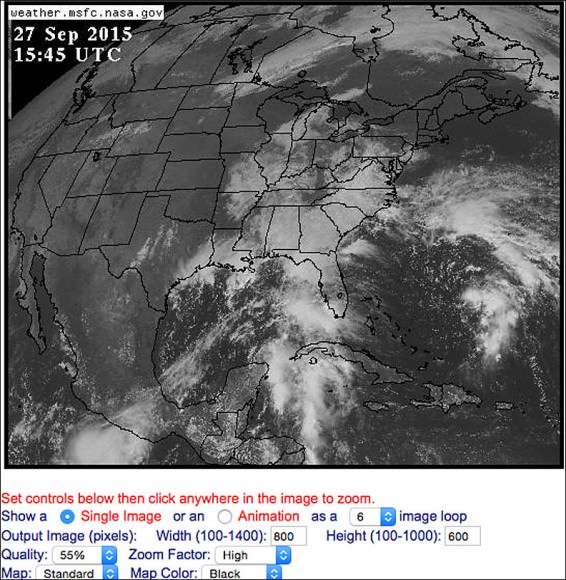
I usually check the GOES (Geostationary Operational Environmental Satellite) images that weather forecasters use to display and animate the movement of clouds and weather fronts during the nightly newscasts. Once I know the location and general drift of the clouds, I get in a car and drive to where it’s likely to either remain or become clear. Depending on the “magnitude” of the event I might drive 50 to 150 miles. If nothing else, doing astronomy guarantees many adventures.
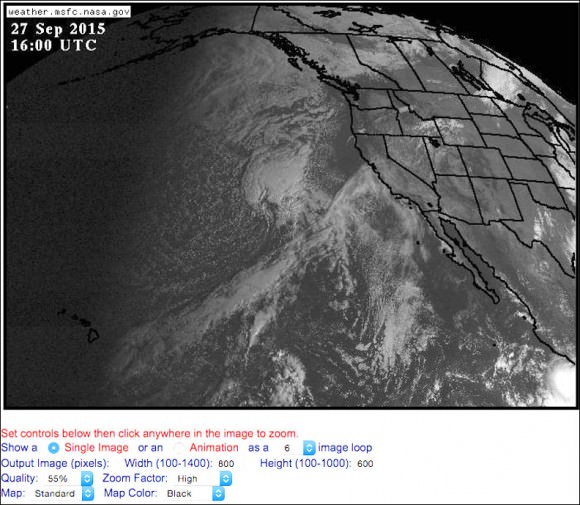
You’ll find these most helpful images at either the GOES East site, which features a photo of the entire mainland U.S., Central America and much of Canada, updated every 15 minutes. Since the satellite taking the photos is centered over the 75° west parallel of longitude, its focus is primarily the eastern two-thirds of the U.S. and Canada. For the western U.S., western Canada and Hawaii, head over to the GOES West site.
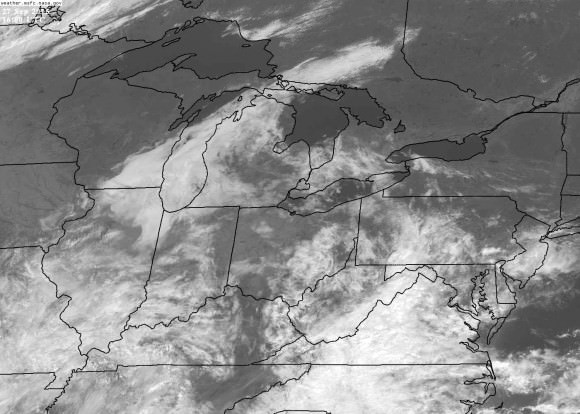
Once there, you’ll be presented with a big picture view of the U.S., etc., but you can click anywhere on the map for a zoomed-in look at a particular region. Before you do, set the “width” and “height” boxes to their maximum values of 1400 (width) and 1000 (height). That way you’ll get a full-screen, nifty, 1-kilometer image when you go in close. All images have a time stamp in the upper left corner given in Universal or Greenwich Mean Time (GMT). Subtract 4 hours to convert to Easter Daylight; 5 for CDT; 6 for MDT and 7 for PDT.
You can check back all day long for fresh photos and watch the march of the clouds over time. Or you can have the site assemble up to 30 of the most recent images into an animation loop and watch it as a movie. Combing current photos, the animation and your local forecast will inform your plans about whether to remain at home to watch the eclipse or get the heck out of town.
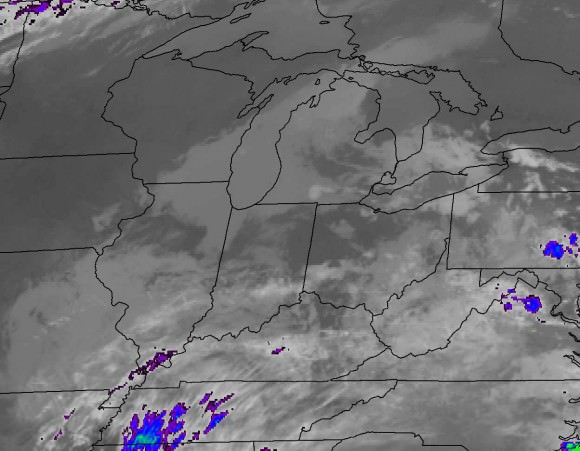
When night arrives, you can still get a reasonably good idea of where the clouds are and aren’t by clicking on the infrared channel link at the top of the site. I also like to use the NCAR (National Center for Atmospheric Research Real-Time Weather Data) site. They offer a black and white infrared option that provides a clearer picture. At the site, select your “channel” then click on one of the regional acronyms on the interactive U.S. map.
So far, we’ve been talking about the weather in real time. When it comes to forecasts, one of the most useful tools of all and a true godsend to amateur astronomers is Attilla Danko’s ClearDarkSky site. Click on the Clear Sky Charts link to access interactive charts for thousands of locations across the U.S., Canada and parts of Mexico. For example, if you click on Illinois, you’ll get a list of sky conditions for 105 locations throughout the state. The Chicago link pops up six rows of data-packed squares with colors ranging from deep blue to white.
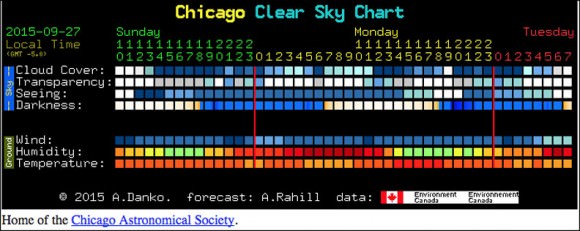
The first row indicates cloud clover with varying shades of blue representing the percentage of clear sky. Medium blue means partly cloudy; white indicates 100% overcast. Additional data sets include sky transparency, seeing conditions, hours of darkness, wind, temperature and humidity. While no forecast is 100% accurate, the reliability of the models Danko uses makes Clear Sky Charts one of best tools available for skywatchers. Want a real treat? If you click on one of the squares in the Cloud Cover row, a large image showing cloud cover at the time will pop up. You’ll also find another, more general interactive cloud forecast graphic at WeatherForYou.com.
Thanks to a helpful reader suggestion, I recently learned of Clear Outside, a forecasting site similar to Clear Sky Charts but worldwide. Be sure to check it out. Satellite imagery like the U.S. GOES East and West is available for European and African observers at Sat24.
So what does the U.S. look like for weather tonight? Mostly clear skies are expected from New York State up through Maine, across the center of the country, the desert Southwest and the Northwest. Expect partly cloudy conditions (with some mostly cloudy spots) for the Upper and central Midwest, and mostly cloudy to overcast skies in the southern and southeastern seaboard states.
But who knows? By using these sites, you might just improve your chances of seeing what promises to be a spectacular lunar eclipse tonight. Some of you reading this undoubtedly have your own favorite weather hangouts. Please share them with us in the comments section. The more the merrier!
As always, if you’re completely shut out, here are a few sites where you can watch it live on the Web:
- Gianluca Masi’s Virtual Telescope starting at 9:45 p.m. CDT (2:45 UT)
- Sky and Telescope webcast begins 8 p.m. CDT (1:00 UT)

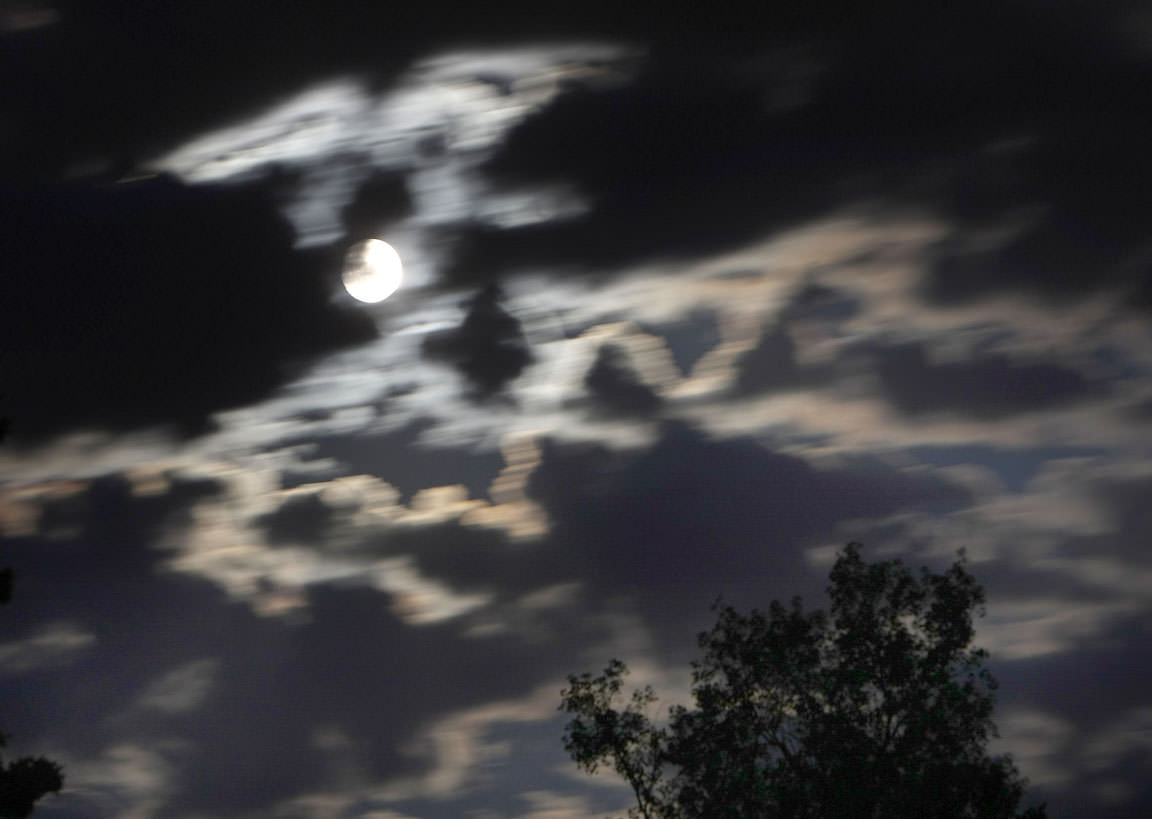
Disappointingly US-centric article. All your links and emphasis is on the USA. The eclipse is visible in Europe too!
Stockport,
Sorry, but I’m not as familiar with European sites and unaware of any site like Clear Dark Sky in Europe. The coverage included not just the U.S. but also Canada and Mexico. I did include the Sat24 link for European observers as well as a call-out for readers to submit their own favorites. You may have missed it. All that said, if you have sites you think would be helpful for European readers, please send them to me at: [email protected] and I would be most happy to include them.
Bob we have been trying to comment without success ..
I’ll bookmark those sites under weather.. Thanks! I like the spot on NWS 7 day forecast map. With this program, you move a box to the site you want and it will give you the weather for that location. Handy if you are planning observations somewhere remote. http://forecast.weather.gov/MapClick.php?lon=-123.14845&lat=38.46325#.Vgh3f7Syj8t
Just went to the Clear Sky Chart and typed in my location/co-ordinates… and BINGO got the report. THAT is just so WAY double extra groovy cool and a handy tool to boot! ThanxX2!
Bob conditions in Europe are Perfect and because the (full) Moon is the closest to Earth in 30 years it looks 14% Bigger and 30% Brighter and it is Already turning colour this will go Blood Red in a Couple of hours and will finish at 06:24 am BST (add one hour for mainland Europe) I am in Belgium in my Garden Astro Party conditions are Perfect (wish you were all here lol) Don’t Miss It the next Supermoon Total Eclipse is in 2033AD so enjoy this one and I Hope Bob gets some Great Photo Shots Good Luck in USA….
UFOs,
Woo-hoo! I kept watch on the clouds, drove southeast into Wisconsin and had clear skies for much of the eclipse. Rather dark to me – Danjon L=2. Glad it was clear in Belgium 🙂
Yeah – entirely socked in by clouds. Clear skies were hundreds of miles away… (sigh)
Very, very nice viewing last night! Ran into an old friend and made some new ones.Thanks sister Selene!